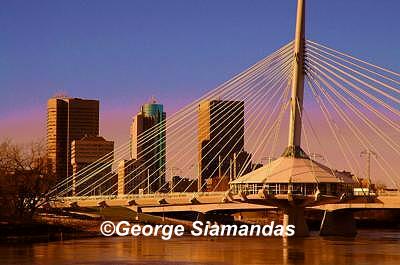
WINNIPEG'S PERIOD OF UNSHAKEABLE OPTIMISM
By George Siamandas
INTRODUCTION
As we look forward in this new century, we pause to look back a century to when a new era was unfolding for Winnipeg. What was it Winnipeg had then? What can we learn from that fabulous period? And what can we use in Winnipeg's next century?
WINNIPEG IN 1903
At the beginning of the century Winnipeg reached forward, and it looked proudly at what it already had become in barley 30 years as a city. From a "desert of snow" to becoming the third largest Canadian City.
Winnipeg had survived and prospered after the 1881-1882-land boom and bust. And while in the early 1880s Winnipeg had a population of 25,000, several thousand still lived tents.
By 1900 our population was 42,000 in the inner city alone. More than a third had been foreign born and half was from Britain.
RAILWAYS, WAREHOUSES, GRAIN & BANKS
Winnipeg had railways and warehouses. In the first nine months of 1903 108,000 settlers came through town on their way west. There was the Grain Exchange and burgeoning agricultural industry. And a booming financial district. Business was so good the banks of the early 1900s were all replaced by the beginning of WW1. Even larger and more opulent and faced in terra cotta, granite and local limestone, they were now as good as those in New York or London.
Banks, real estate companies, merchants, and shops formed a continuous ribbon of commerce equally on both sides of Main St from the St Boniface bridge to the CPR tracks.
A MODERN CITY
Winnipeg boasted a water supply, three fire stations, and a fine new Carnegie Library. There were 125 miles of paved roads and 179 miles of plank sidewalks. Seventy miles of sewers and 80 miles of water mains served from artesian wells.
Winnipeg boasted of its wide main streets set at 133 feet across. Three beautiful parks with plans to buy an old dairy farm and turn it into Assiniboine Park. There were 18 public schools and several more private ones. And the faithful had 60 churches and a dozen faiths. And they were churchgoers then. Crime was virtually none existent.
THE FUTURE IN 1900
Winnipeg's first skyscraper, the Royal Tower was about to be built. And there was talk of a giant new store to be built by Eaton's on Portage Ave.
So much of the future was being planned on Portage. Banks and the Post Office were buying land and planing their moves to a Portage Ave address.
A THRIVING CITY
In the decade between 1905 and 1915 Winnipeg's population tripled in size. In this ten-year period banks, financial firms, insurance companies, and private investors built some of the finest architecture in North America.
We would plan a water supply system that would last for centuries to supply more than a million people. Our telephone system would become a public monopoly and so would the future electrical needs for a bustling metropolis. Everything was planned to be first class.
SELLING THE BOOM TOWN
It was a period of unshakeable optimism. And of aggressive and competitive promotion of Winnipeg.
Winnipeg's Industrial Development Bureau fielded 57,000 enquiries between 1907-1910, sending out 2 million pieces of literature, 2,000 photos, 1,000,000 lines of copy on Winnipeg themes to national and international publications.
By 1913 Winnipeg was a metropolis. Its growth and prosperity was unrivalled in Canada. What is remarkable is that so many of these buildings survive today.
TODAYThe question is what are we planning for this century that will be noteworthy when Winnipeggers look back?


No comments:
Post a Comment